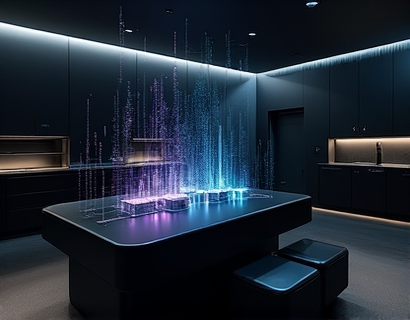Unlock Real-Time Engagement: Transforming Live Communication with Advanced AI Avatar Technology
The landscape of digital communication is rapidly evolving, driven by advancements in artificial intelligence and machine learning. One of the most exciting developments in this realm is the emergence of advanced AI avatar technology, which is revolutionizing the way we engage in live presentations and virtual events. This technology brings to life dynamic, real-time interactions, creating lifelike and engaging characters that enhance the overall experience for audiences worldwide.
AI avatars are not just a novelty; they represent a significant leap forward in interactive and memorable communication. By integrating sophisticated AI with cutting-edge design, these avatars can convey messages with a level of nuance and expressiveness that was previously unattainable in digital environments. This article delves into the transformative potential of AI avatar technology, exploring how it is reshaping the future of live communication and offering unparalleled opportunities for businesses and content creators.
The Rise of AI Avatars in Digital Communication
The concept of using avatars in digital communication is not new, but the integration of advanced AI has elevated this technology to unprecedented levels. Traditional avatars were often static and lacked the ability to interact in real-time, limiting their effectiveness in engaging audiences. With the advent of AI, avatars can now respond to cues, adapt to different scenarios, and maintain a natural flow of conversation, making them far more compelling and relatable.
The applications of AI avatars are vast, spanning various industries including education, entertainment, business, and healthcare. In the corporate world, AI avatars are being used to enhance virtual conferences, product demonstrations, and customer service interactions. These avatars can provide consistent, high-quality communication, reducing the need for human presenters in certain scenarios while still delivering a personal and engaging experience.
Real-Time Interaction: The Key to Engaging Audiences
One of the most significant advantages of AI avatars is their ability to engage in real-time interactions. Unlike pre-recorded videos or static images, AI avatars can respond to questions, acknowledge audience feedback, and adapt their behavior based on the context of the conversation. This dynamic interaction not only captivates the audience but also fosters a deeper connection, making the communication more impactful and memorable.
Real-time interaction is achieved through a combination of natural language processing (NLP) and machine learning algorithms. These technologies enable the avatar to understand and interpret human language, allowing for seamless and natural conversations. The avatar can also use facial expressions, gestures, and tone of voice to convey emotions and enhance the authenticity of the interaction.
Enhancing Live Presentations with AI Avatars
In the context of live presentations, AI avatars can serve as virtual co-presenters, augmenting the speaker's message with visual and interactive elements. For instance, an AI avatar can display real-time data, animations, or 3D models to illustrate complex concepts, making the presentation more engaging and easier to understand. This dual-presentation format can be particularly beneficial in educational settings, where complex subjects require multiple modes of explanation.
Moreover, AI avatars can handle logistical aspects of a presentation, such as managing Q&A sessions, providing additional resources, or even moderating discussions. This allows the human presenter to focus on delivering the core message, leading to a more effective and efficient communication process.
Transforming Virtual Events with AI Avatars
Virtual events, including conferences, trade shows, and webinars, have become increasingly popular, especially in the post-pandemic world. However, these events often suffer from a lack of engagement and interaction. AI avatars can transform the virtual event experience by providing a more immersive and interactive environment.
AI avatars can act as virtual hosts, guiding attendees through the event, introducing speakers, and facilitating networking opportunities. They can also serve as information booths, offering detailed insights into products or services, and answering questions from attendees. This level of interaction not only enhances the attendee experience but also increases the likelihood of converting leads into customers.
Additionally, AI avatars can help organizers manage the event more efficiently. They can monitor attendance, track engagement levels, and provide real-time analytics, allowing organizers to make data-driven decisions to improve future events.
Creating Lifelike and Memorable Experiences
The lifelike nature of AI avatars is a key factor in their ability to create memorable experiences. Advanced AI algorithms enable these avatars to exhibit a wide range of emotions and expressions, making them more relatable and human-like. This emotional connection is crucial in building trust and rapport with the audience, which is essential for effective communication.
The design of AI avatars is also highly customizable, allowing businesses and content creators to tailor the appearance and behavior of their avatars to align with their brand identity. Whether it's a friendly and approachable character for a consumer brand or a professional and authoritative figure for a corporate entity, the avatar can be designed to perfectly match the desired image.
Integrating AI Avatars into Various Platforms
The versatility of AI avatar technology extends beyond specific applications, as these avatars can be integrated into a wide range of platforms and environments. From social media and messaging apps to augmented reality (AR) and virtual reality (VR) experiences, AI avatars can enhance user interactions across multiple channels.
In social media, AI avatars can serve as digital representatives, responding to comments and messages, and even participating in live streams. In AR and VR, avatars can create immersive experiences, allowing users to interact with virtual environments in a more natural and intuitive way. This cross-platform compatibility ensures that the benefits of AI avatar technology can be harnessed in various contexts, maximizing their potential impact.
Challenges and Considerations
While the potential of AI avatar technology is immense, there are several challenges and considerations that need to be addressed to fully realize its benefits. One of the primary challenges is ensuring the naturalness and fluidity of the avatar's interactions. This requires continuous improvement in NLP and machine learning algorithms to handle the complexity and nuance of human language and behavior.
Another consideration is the ethical use of AI avatars. As these technologies become more advanced, concerns about privacy, data security, and the potential for misuse arise. It is crucial for developers and organizations to establish clear guidelines and best practices to ensure that AI avatars are used responsibly and ethically.
The Future of AI Avatar Technology
The future of AI avatar technology is bright, with ongoing advancements promising even more sophisticated and capable avatars. As AI research progresses, we can expect improvements in areas such as emotional intelligence, context understanding, and physical realism. These enhancements will further blur the line between virtual and real interactions, making AI avatars an even more integral part of our digital lives.
Moreover, the integration of AI avatars with other emerging technologies, such as 5G, IoT, and blockchain, will open up new possibilities for real-time, secure, and seamless communication. The combination of these technologies will create a more interconnected and intelligent world, where AI avatars play a central role in facilitating human-to-human and human-to-machine interactions.
Conclusion
AI avatar technology represents a significant leap forward in digital communication, offering unparalleled opportunities for businesses and content creators to engage and interact with their audiences in innovative and impactful ways. By leveraging the power of advanced AI, these lifelike characters can transform live presentations and virtual events, creating memorable and engaging experiences that set a new standard for interactive communication.
As the technology continues to evolve, the potential applications and benefits of AI avatars will only grow, making them an essential tool for anyone looking to stay ahead in the digital landscape. Embracing this technology can lead to more effective communication, deeper audience engagement, and a more connected world.













